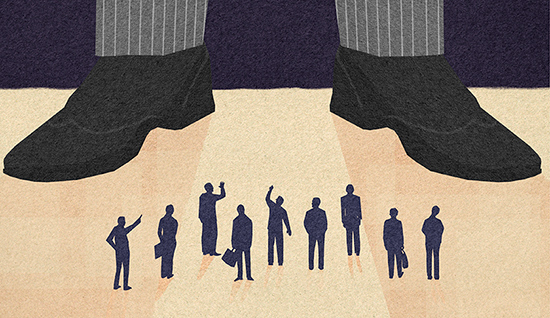高管的薪酬凭什么比你多300倍?

|
本周,我得到一个“霸凌者”的称号。 之所以得到这个称号,原因在于美国证券交易委员会在周三投票通过了要求公司披露首席执行官与员工薪酬差距的法规。委员们的投票结果与党派比例一致——3:2。 在一项异议声明中,证券交易委员会的共和党委员迈克尔·皮窝沃表示,他的同事“对于霸凌现象持默许态度”。 如果说支持披露首席执行官-员工之间的薪酬差距都能够让人成为霸凌者的话,那么我算是其中一个。大型公司首席执行官的薪酬是车间员工薪资的数百倍,多年来,我一直认为公司内部的这种极端不平衡不仅仅只是公平性的问题,而且也会给企业带来负面影响。 例如,斯坦福大学对多个调查的评估发现,顶层和底层员工巨大的薪资差距可能会打击雇员的士气和工作满意度。CtW Investment Group对标普500公司的分析显示,首席执行官-员工薪资比值估值较大的企业在五年期内的股东回报率要低于那些估值低的企业。 2010年,多德-弗兰克金融改革将首席执行官-员工薪资比率披露写入了美国的法律。但五年以来,证券交易委员会的官员在面临激烈反对的情况下,对于法规的实施一拖再拖。 企业说客组织和同一阵营的决策者们一直在不遗余力地阻挠或架空这一规定。有时候,我不得不承认,我也曾经用过不怎么中听的言语来还击其攻击。 例如去年,美国商会发布了一项调查,称大型公司平均得耗费311800美元以及1825小时的时间来计算器员工薪酬中间值。我忍不住想要执笔为这些 “拖沓而又昂贵的会计” 写一封假招聘广告。这些公司从哪里弄来的上述荒唐数据? 当然,我并非是唯一一个在这一方面异常吝啬之人。证券交易委员会就这个问题收到了28.74万封评论函,绝大多数都对此表示支持。 皮窝沃在其异议声明结尾还提醒人们吸取有关校园霸凌事件的教训。他说:“默许只会助长霸凌者的气焰。” 这一点确实有道理。那些提倡薪酬差距披露的人的确会利用这场胜利来提出更多的要求。具体来说,新联邦法规将帮助我们推广国家层面的动议,以便通过公共资金的力量来提升披露的吸引力。 例如,罗德岛州参议院法案规定,对于首席执行官与员工薪资中值比例低于25:1的公司,在申请政府项目时会获得优惠。这一基准源于管理学之父皮特·德拉科,他认为高管-员工的薪酬比例高过20:1之后就会有损公司的士气和生产力。 依据这一法律,竞争州政府项目的公司可以通过降低其薪酬差距来改善其中标机会,它们可以降低高管薪酬,或提升其最底层员工的薪资水平。不管采取哪种方式,罗德岛纳税者的钱会发挥更大的效用,因为薪资差距的缩小有可能会提升生产力。税收政策可能也会通过为低薪资差距公司提供更低的税率,来奖励薪资差距更公平的企业。 有人认为自己是这场所谓的薪资差距“霸凌”现象的牺牲者,而且他们并非只是停留在向主管方抱怨。就在证券交易委员会投票数小时之后,众议院金融服务委员会主席杰布·亨萨林(德州共和党)宣布一项法案投票计划,旨在废除多德-弗兰克法案中的这一部分内容。 那些薪酬过高的首席执行官似乎依然在鼓动其在国会的大哥,尽其所能地让这些恃强凌弱的大坏蛋知难而退。然而,一旦角斗上演,真正会黑着眼圈离场的将是那些企业高管。(财富中文网) 萨拉·安德森在政策研究所主持一个全球经济项目。 译者:冯丰 审校:夏林 |
This week I got called a bully. What provoked the name-calling was a Securities and Exchange Commission vote on Wednesday to adopt regulations requiring corporations to disclose the gap between what they pay their CEO and their workers. The commissioners voted 3 to 2 along straight party lines. In a dissenting statement, SEC Republican Commissioner Michael Piwowar said his colleagues were “acquiescing to bullies.” If supporting CEO-worker pay ratio disclosure makes you a bully, then count me among them. For many years, I’ve argued that extreme inequality within firms, with big company CEOs making hundreds of times more than shop floor employees, is not just grossly unfair. It’s also bad for business. A Stanford University review of several studies, for instance, found that highly differentiated pay between top and bottom earners tends to reduce employee morale and job satisfaction. A CtW Investment Group analysis of S&P 500 companies indicated that those with high estimated CEO-worker pay ratios had lower shareholder returns over a five-year period than companies with low CEO-pay ratios. In 2010, the Dodd-Frank financial reform made CEO-worker pay ratio disclosure the law of the land. But for five years, in the face of intense opposition, SEC officials have dragged their feet on implementation. Corporate lobby groups and allied lawmakers have been bent on blocking or gutting the rule. And there were times, I must admit, when I responded to their attacks in a less than kindly manner. Last year, for example, the U.S. Chamber of Commerce published a study claiming large companies would be forced to shell out an average of $311,800 and crunch numbers for 1,825 hours to calculate their median worker pay. I couldn’t resist penning a phony help wanted ad for “slow and expensive accountants.” How else could these companies back up such absurd numbers? Of course I’m not the only big meanie. The SEC received more than 287,400 public comment letters on this issue, an overwhelming majority of which were supportive. At the end of his dissenting statement, Commissioner Piwowar reminded us of schoolyard lessons about bullies. “Acquiescing,” he said, “only gives them more ammunition.” Here he does have a point. Those of us who’ve advocated for CEO-worker pay disclosure will indeed be using this victory to push for more. Specifically, this new federal rule will help us promote state-level initiatives to add extra oomph to disclosure by tapping the power of the public purse. A Rhode Island state senate bill, for example, would give preferential treatment in the awarding of government contracts to firms that have gaps between CEO and median worker pay of no more than 25 to 1. This benchmark was inspired by Peter Drucker, known as the Father of Management Science, who believed the ratio of pay between worker and executive can run no higher than 20-to-1 without damaging company morale and productivity. Under this legislation, companies competing for state contracts could improve their chances by reducing their pay gaps — either by lowering executive compensation or lifting up wages at the bottom of their pay scale. Either way, Rhode Island taxpayers would get a bigger bang for their buck, since narrower wage divides are likely to boost productivity. Tax policy could also reward companies with more equitable pay practices by offering lower rates for narrower gaps. Those who imagine themselves to be the victims of all this so-called bullying on pay gaps are not just running home to mommy. Within hours of the SEC vote, House Financial Services Committee Chair Jeb Hensarling (R-TX) announced plans for a vote on a bill to repeal this section of Dodd-Frank. Similar legislation has been introduced in the Senate. Overpaid CEOs, it seems, are still turning to their big brothers in Congress to try to scare off the big bad bullies. But in dragging out this fight, the corporate chiefs are the ones who will be left with the black eyes. Sarah Anderson directs the Global Economy Project at the Institute for Policy Studies. |













